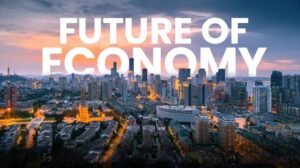The Economy of Tomorrow: Adapting to an Aging Future and Technological Transformation
Humanity faces unprecedented challenges as we approach the future economy. From aging populations to technological upheaval, urbanization, and sustainability, we must grapple with issues that will define the way we live, work, and thrive. The Fourth Industrial Revolution, marked by the rise of artificial intelligence (AI), robotics, and other advanced technologies, has already begun reshaping industries, social structures, and even our understanding of what it means to be human.
This article explores these challenges and opportunities, offering insights into how the global economy might evolve as we confront the realities of an aging future and disruptive innovation.
The Aging Future: A Global Challenge
By 2050, nearly 2.1 billion people worldwide will be aged 60 or older, according to the United Nations. This demographic shift, driven by declining birth rates and increased life expectancy, presents profound implications for economies, healthcare systems, and social policies.
Workforce Challenges and Economic Growth
As populations age, the working-age population declines, creating labor shortages in key sectors. Countries like Japan and Germany are already experiencing these effects, and other nations will soon follow. The aging workforce threatens economic growth, reducing productivity while increasing the financial burden on social security systems and healthcare.
The Silver Economy
Aging populations also create opportunities. The so-called “silver economy” refers to goods and services tailored to older adults, including healthcare technologies, housing, and travel. Autonomous vehicles, for instance, could restore mobility and independence for the elderly, while advancements in personalized medicine promise longer, healthier lives.
Intergenerational Equity
A critical question remains: how can we balance the needs of older and younger generations? Without proactive policy measures, younger workers may bear the economic burden of supporting retirees, potentially exacerbating generational inequalities. Solutions such as pension reforms, encouraging longer working lives, and investing in automation to fill labor gaps will be vital.
The Fourth Industrial Revolution: Disruptive Technology
The Fourth Industrial Revolution is characterized by a fusion of technologies that blur the lines between the physical, digital, and biological spheres. Key players in this transformation include AI, big data, robotics, and biotechnologies.
AI and Automation
AI is already revolutionizing industries. From self-driving cars to machine-learning algorithms that diagnose diseases, AI is poised to enhance efficiency and productivity. However, its disruptive potential is immense. Millions of jobs across sectors—ranging from trucking to finance—could be automated, leading to widespread unemployment. Studies suggest up to 50% of current jobs are at risk of automation over the next two decades.
The New Workforce Reality
While past industrial revolutions created more jobs than they destroyed, many experts warn that this time could be different. Technologies like machine learning can outperform human capabilities in fields once considered safe, such as journalism, law, and even creative arts. Policymakers face the monumental task of retraining displaced workers and ensuring new job opportunities emerge in industries yet to be imagined.
Big Data and Personalized Solutions
Big data drives the Fourth Industrial Revolution, enabling precise predictions, personalized services, and innovative products. In healthcare, for instance, big data is accelerating drug development and enabling early disease detection. IBM’s Watson, for example, is helping doctors analyze medical records to improve treatment outcomes. These advancements promise to revolutionize how we approach everything from public health to business strategy.
Ethical Concerns and Inequality
The benefits of the Fourth Industrial Revolution are not distributed equally. Wealthy individuals and corporations with access to cutting-edge technologies may consolidate power, exacerbating inequality. Ethical questions also loom large: How do we ensure AI operates fairly? How do we protect jobs while fostering innovation? And what role should governments play in regulating disruptive technologies?
Urbanization and the City of the Future
For the first time in history, more than half the world’s population lives in urban areas, with cities driving 50% of global GDP. By 2025, this figure is expected to rise to 66%. Urbanization presents both immense opportunities and daunting challenges.
Mega-Cities and Rapid Growth
Emerging economies in Asia and Africa are experiencing unprecedented urban expansion. Cities like Lagos, Nigeria, and Mumbai, India, are growing at staggering rates, straining infrastructure and resources. Unplanned growth leads to gridlocked streets, polluted air, and inadequate housing. Slums, where over 800 million people live globally, are often the result of such rapid urbanization.
Smart Cities: A Vision of Sustainability
Advanced technologies can address many urban challenges. Smart cities leverage IoT (Internet of Things) devices, big data, and AI to optimize transportation, energy use, and public services. For example, Rio de Janeiro’s innovative urban initiatives use citizen data to address inequality and improve infrastructure. Cities must embrace these solutions to remain sustainable and livable.
Urban Inequality
As cities grow, so do disparities between wealthy and poor neighborhoods. Access to education, healthcare, and transportation often depends on location. Urban planners must focus on inclusive growth, ensuring that investments in infrastructure benefit all residents, particularly marginalized communities.
Community-Driven Solutions
Grassroots efforts in urban planning can inspire change. In Lagos, for instance, slum residents have created floating schools and developed their own water and electricity systems. Supporting these initiatives while integrating them into broader urban strategies could transform cities into hubs of innovation and inclusivity.
Gender and the Economy of Tomorrow
While technological and urban advancements dominate discussions of the future, closing the gender gap remains a critical component of economic progress. Women represent half the global population but face systemic barriers in the workforce and leadership roles.
Economic Potential of Gender Equality
Closing the gender gap could add $26 trillion to the global economy by 2025, according to McKinsey. Companies with diverse leadership tend to perform better, innovate more effectively, and attract top talent. Yet, women hold less than 20% of corporate board seats globally, and only 5% of Fortune 500 companies have female CEOs.
Challenges Women Face
Women continue to shoulder the majority of unpaid caregiving responsibilities, limiting their career opportunities. Workplace cultures often fail to accommodate the realities of family life, forcing women to choose between professional success and personal obligations.
Lessons from Scandinavia
Scandinavian countries are leading the way in gender equality. Policies such as mandatory paternity leave, subsidized childcare, and flexible work arrangements have narrowed the gender gap, enabling both men and women to balance work and family life. These models provide valuable lessons for other nations striving for equality.
A Call to Action: Building the Economy of Tomorrow
The challenges of tomorrow require bold action today. Policymakers, business leaders, and individuals must work together to navigate the complexities of an aging population, technological disruption, and rapid urbanization. Key strategies include:
Investing in Education and Reskilling
Education systems must adapt to prepare workers for future jobs. Lifelong learning initiatives and retraining programs will be essential to help displaced workers transition into new industries.
Promoting Inclusive Policies
Governments must implement policies that reduce inequality, protect vulnerable populations, and ensure that technological advancements benefit society as a whole.
Fostering Collaboration
Public-private partnerships can drive innovation and create scalable solutions to global challenges. Collaboration across sectors and borders will be vital to building a sustainable, equitable economy.
The economy of tomorrow is not preordained; it will be shaped by the choices we make today. By embracing innovation, fostering inclusivity, and addressing the pressing needs of an aging future, we can build a world where prosperity and opportunity are accessible to all.










Leave a Reply